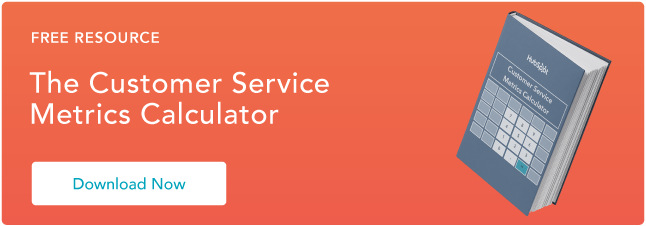Customer service is the backbone of every business, as its relationship with its customers directly affects its success.

As such, measuring your customer service KPIs is crucial to successful customer interactions. Take Trader Joe’s for example. It’s one of the most customer centric-companies in the US. Why? They focus on the customer service experience. Trader Joe’s customers love the company so much that the chain has the highest American Customer Satisfaction Index (ACSI) score.
Trader Joe’s are likely able to excel because they monitor critical metrics related to the service they provide. In this post, learn about critical customer service and service desk KPIs that will help you understand your support strategies and improve customer satisfaction.
loading="lazy"Skip to:
Customer Service KPI Examples
Key performance indicators are a measurement tool used to measure employee and company performance. They are necessary for businesses to establish, measure, and evaluate goals. Customer service KPIs include:
1. First Response Time
First response time (FRT) is the time that elapses between a customer sending their first support ticket and an agent’s response.
Using this metric helps a company measure the effectiveness of its team when it comes to the promptness of support staff and whether teams have enough resources to respond to requests on time. Delays in response time can negatively affect a customer’s interaction with a business, making it one of the most monitored customer service KPIs.
2. Average Resolution Time
Average resolution time is how long it takes to solve a support ticket from start to finish, and the length of time usually varies based on the complexity of the issue. However, lower resolution times are a better marker for success as they ensure quick resolutions of customer calls.
.png)
Free Customer Service Metrics Calculator
Calculate your business's key metrics and KPIs for customer support, service, and success with this free template.
- Customer Acquisition Cost
- Customer Lifetime Value
- Customer Satisfaction Score
- And More!
3. Average Handle Time
Average handle time (AHT) is similar to average resolution time, but there is a slight difference.
AHT is the average time an agent spends on a ticket. For example, suppose a support rep is resending a package to a customer. The handling time ends when the agent communicates the new shipping information to the customer and closes the ticket. The resolution time ends once a customer actually receives the product.
4. Consistent Resolutions
In addition to resolution times, providing consistent resolutions is also an important metric. Think of your customer service operation like McDonald’s where customers get consistent service across the board. No matter what agent they speak with — whether via chat, email or phone – they are providing consistent answers to customers reporting the same issue.
Pro tip: You can leverage AI software to help you track how service agents are responding to the same customer queries and note any discrepancies in communication.
5. Top Topics
Analyzing the reasons why customers contact support is just as important as how fast their issues are resolved. Monitoring customer-reported issues can help you determine gaps in your instruction and training materials. If you find a pattern or that folks are reporting the same issue, it may be a sign of a larger problem.
Pro tip: If customers are reporting issues troubleshooting the same problem, it may mean you need to revisit your knowledge base or build out new help features.
6. Cost Per Resolution
Calculating how much it costs to resolve each ticket is critical to determining staffing and operating costs. To find your cost per resolution, take your total service department costs for a given time period and divide them by the number of tickets resolved for the same time period.
Cost per resolution = Total operating expenses / # tickets resolved
Let’s say your total operating costs are $20,000 per month and your team resolved 2,000 tickets. Your cost per resolution would be $10.
Pro tip:
Adopting AI technology to help you respond to tickets can lower your cost per resolution.
7. Number of Tickets
A necessary part of customer service is anticipating how many issues can arise. Problems are bound to happen. This metric indicates whether the team is equipped and available to handle the number of tickets.
8. Number of Resolved Tickets
This KPI refers to the number of tickets an individual agent or team as a whole has received and resolved within a given period.
9. Number of Tickets by Medium
The number of tickets by medium KPI refers to the number of tickets per different channels customers use to reach out to support teams. For example, the total number of individual tickets opened over the phone, via email, live chat, or social media.
10. Escalation Rate
The escalation rate is a percentage that represents the number of support tickets that escalate to a person with more experience or specialized knowledge. The person receiving the escalated ticket is typically a supervisor or manager.
11. Customer Retention Rate
Customer retention measures a company’s ability to retain customers over time. It’s one of the more important metrics to know because customer retention is integral to your success as a company. Plus it increases customer loyalty, ROI, and helps recruit new customers.
Use the following formula to calculate it:
[ (# Customers at End of Period — # Customers Acquired During Period) / # Customers at Start of Period] x 100
12. Customer Satisfaction Score
Typically after an experience with support staff, customers are encouraged to fill out a survey based on their experience. Customer Satisfaction Scores(CSAT) show how happy customers are with the service provided and how well customer service team members handle customer issues and complaints.
13. Net Promoter Score
The Net Promoter Score (NPS) is a satisfaction benchmark that measures how likely your customers are to recommend your business to someone else. You get an NPS score by surveying customers and asking them “on a scale of 1 to 10, how likely are you to recommend us to a friend?” Customers that rate you a 9 or 10 would be considered promoters, and as the name implies, most likely to promote your brand. The rest of the scores break down as follows:
- Detractors: scores 0 to 6
- Passives: scores 7 and 8
- Promotors: scores 9 and 10.
To calculate Net Promoter Score, subtract the percentage of detractors (wouldn't recommend you) from the percentage of promoters (would recommend you).
Pro tip: NPS scores aren’t just for customers. You can deploy a similar survey to your service team to measure job satisfaction.
14. Customer Effort Score
Part of offering excellent customer service is reducing friction for your customers. After all, customers shouldn’t feel like resolving their issue is a worse experience than what they were contacting the service team about in the first place.
The customer effort score measures how much effort your customer had to put into resolving their issue. To determine the customer effort score, ask your customer to rate their resolution experience on a scale from easy to difficult. You can collect feedback from customers right after they’ve had certain touchpoints or interactions with your company, like making a purchase or contacting the service team.
15. Top Performing Reps
Your service reps are on the frontlines of customer interaction and satisfaction. You can use your service desk to track who your top performers are. You’ll want to recognize reps that solve the most tickets, have the most first-resolution tickets, and deliver high customer satisfaction results.
Once you identify your top performers, you can not only reward their hard work but tap into their successful strategies to help improve the rest of the team.
Not all businesses can have large customer service teams, and many rely on service desks to manage their budgets, resources, and customer service all at once. Customer service KPIs and service desk KPIs are relatively similar, but it’s essential to understand their different applications.
.png)
Free Customer Service Metrics Calculator
Calculate your business's key metrics and KPIs for customer support, service, and success with this free template.
- Customer Acquisition Cost
- Customer Lifetime Value
- Customer Satisfaction Score
- And More!
Service Desk KPIs
A service desk, often automated, is a program that manages the communication between a company and its customers. Most platforms give businesses a collaborative system with features that include a shared inbox, canned responses and actions, app integrations, and advanced metrics reporting.
The key performance indicators of service desks are similar to that of standard customer service KPIs but focus on the timeliness and effectiveness of the automated systems through metrics like average resolution time, resolved tickets, and CSAT.
In addition to those already featured on this list, the following are additional metrics used to measure service desk performance.
1. First Contact Resolution Rate
First contact resolution rate is different from the average resolution time as it measures the percentage of tickets solved during initial content. While it is a marker for efficiency, it can skew metrics as some issues are more complex and require more time to resolve.
2. Average Reply Time
Average reply time measures how long it takes agents to respond to customer queries across all communication with a customer, not just how long it takes to respond to initial outreach. For example, the amount of time it takes the agent to respond to each chat message sent by a customer.
3. Agent Touches Per Ticket
Customers look to have their problems solved quickly, so they typically dislike the constant back and forth to solve a problem. Agent touches per ticket is the number of times an agent communicates with a customer before resolving an issue. A high number of touches per ticket can negatively affect the customer satisfaction rate.
4. Knowledge Base Views
Knowledge base views have nothing to do with customer interaction with an agent. This metric measures the number of page views on FAQ or support pages. It enables companies to identify trends in customer issues based on the volume of their searches.
5. Abandonment Rate
A metric reserved for phone calls, call abandonment rate measures how many callers hang up before speaking to a service agent. High abandonment rates hurt overall customer service and satisfaction. Talkdesk reported that the three industries with the highest average abandonment ratewere the government and public sector (7.44%), transportation and logistics (7.4%), and healthcare (6.91%).
While monitoring all these KPIs can become overwhelming, especially for small businesses, programs like Plectoare effective for keeping track of KPIs. Plecto is an engagement and motivation platform that enables companies to build custom KPIs while providing real-time reports, contests, and achievements for their staff. While they offer solutions for customer service, the all-encompassing platform has assistance for other departments like sales, marketing, and development.
The KPIs are always right.
In business, one often hears the customer is always right. Customer service KPIs are a great indicator of what is actually right in a business. They allow companies to measure the success of their support staff through the efficiency of their work and the satisfaction of their customers. Satisfied customers = successful business.
Editor's note: This article was originally published in January 2022 and has been updated for comprehensiveness.
![→ Download Now: Customer Service Metrics Calculator [Free Tool]](https://no-cache.hubspot.com/cta/default/53/e24dc302-9dc2-466f-a5ca-ab4e08633c0f.png)

![How AI Image Misuse Made a World of Miscommunication [Willy's Chocolate Experience]](https://blog.hubspot.com/hubfs/ai%20image%20misuse%20the%20willy%20wonka%20experience%20%281%29.png)


![How Customer Experience Has Evolved Over the Last Decade [+ 2024 Trends]](https://blog.hubspot.com/hubfs/future-of-customer-experience.png)
![Memorable Examples of AR in Customer Experience [+Tips for Implementing the Technology]](https://blog.hubspot.com/hubfs/augmented%20reality%20customer%20experience.png)

![How to Implement a Hybrid Customer Service Strategy That Works [Expert Tips]](https://blog.hubspot.com/hubfs/hybrid%20customer%20service_featured.png)


![Customer Experience vs. User Experience: What’s the Difference? [+ Examples]](https://blog.hubspot.com/hubfs/customer-experience-vs-user-experience_2.webp)